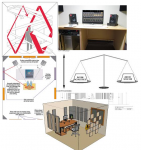OK, this thread is great, thanks OP for this post!
First of all, the interview as a whole made a lot of sense. My approach to mixing is very similar to Joe's, the process needs to be great and it needs to not be in the way of the art. I totally agree that the mixer should be focusing on improving the musical abilities rather than the technical, although I see no reason why they cannot build on each other.
What I noticed a little was the decision of doing tape saturation and console track emulation in the same way on pretty much all the channels. I do think that this has more things to it. First of all, I'm not sure he really only uses a single tape saturation plugin (both in terms of brand/model and nr of instances per track) and a single console track emulation plugin, at least he probably varies the settings. I think that the reason why he did not want to reveil this in detail was because of the considerable amount of time he has spent on choosing which tape saturation and console track emulation plugins should be used on what sound source and how, could be some NDA components to it as well. But it was interesting that he reveiled this approach. Therefore, in my view the takeaway point about this approach, should be that tape saturation and console track emulation when combined and when intelligently dialed in, can bring very interesting characteristics to the sound of your mix.
I call this fighting the "smear effect". The "smear effect" is this: By default everything in a digital DAW is constant. You have a fixed set of plugins to use, a fixed set of controls, a fixed set of default settings, precisely the same fixed behavior from each plugin and so on, very little elasticity in terms of character and element separation in the stereo field. This also kind of leads you into applying the same principles, plugins and settings to everything, in other words rather than building up unique character on each channel of each sound source, it's common to go in the opposite direction. For anyone who is taking note on this approach I do want to share the fact that it can be better not to lock yourself into the idea of going this approach entirely, but rather try to differentiate each sound source as much as possible. For instance on some tracks it could be better to put the console track emulation before the tape saturation. And on some tracks it might work better to use either the tape saturation or the console track emulation plugin and not both.
Another thing to pay attention to about this is the scope of application. If you are an experienced engineer you can immediately tell that putting some particular character on both channels adds more mix character as oppose to adding the character only on one of the channels and that a sound you want to color the mix a lot you should center pan. In the case of Joe's recommendations it makes sense to go the route he recommends, one of the reasons for that is that adding character ITB tends to happen in smaller doses per effect instance, so overall the more plugins ITB the better (as long as you effectively deal with the delay it causes and have control over it), don't be afraid you will end up with too much character ITB very soon. Having said that, please also note that Joe has a strong country music element to his sound, where he wants a lot of emotion in the sound. It's all good. But, this can also lead you into thinking that this ALWAYS works. The truth of the matter is that it works if it suites the particular music well. Now, because adding harmonics to the audio tends to provide resonance/emotion, in this case you still kind of have to consider it a good thing in most genres as a default choice. I would however, add to this that it can make more sense to scope this on a channel (L/R) basis and apply these effects not in serial but in parallel and incorporate this character into your balancing work and also consider the even tighter scope of application which is on the freq band level. I also want to point out that it is important to figure out what effects work well in serial, what effects don't work well in serial, what effects should kick in through a side chain and so on.
Other than that, I do find you should also pay attention to Joe's use of outboard gear. It's simple to describe the elegance of ITB mix templates and signal routing, it's much more difficult to describe what can be done ITB and what cannot be done ITB. Especially important to note is his use of the Urei 1176 compressor on the bass guitar, I found this to be possibly the most valuable point in the interview, simply because there is a lot of value in taking part of gear advice that comes this naturally from a cat of this caliber. So if I would recommend anyone to try out Joe's approach to mixing and gear, it would be the 1176 on the bass guitar. As you all know, the bass guitar sound in country music is sweet!

His emphasis on automation was also great. Please note that when he talks about bringing front various elements in the mix through automation, what he really means is that it is the process of adding vitality to your mix.








